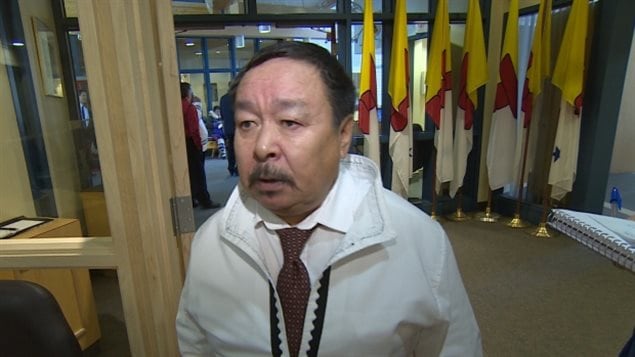Search crews in Canada’s Arctic territory of Nunavut rescued three travellers, including a member of the territorial legislature, after a weeklong search Thursday evening.
Member of the Nunavut Legislature Pauloosie Keyootak, his son Atamie Qiyuqtaq, and Peter Kakkik arrived at Qikiqtani General Hospital in Iqaluit Thursday night tired, hungry and thirsty after being retrieved by a helicopter. All three were discharged a couple of hours later.
Ed Zebedee, the government of Nunavut’s director of protection services, said a chartered Twin Otter plane with local spotters found the three missing men Thursday evening about 183 kilometres south of Iqaluit, in the opposite direction from where they should have travelled to.
“It was a big joy for us,” Zebedee said speaking on the phone from his office in Iqaluit. “I can’t describe it. I don’t think most of the search team slept tonight, they were so excited.”
Wrong turn

Zebedee said throughout the week-long ordeal the volunteer search teams remained optimistic that they would locate the missing travellers.
“We’ve had searches go on much longer with positive outcomes,” Zebedee said. “Most Inuit are very resourceful and can survive on the land for a very long time.”
Keyootak, 62, his 16-year-old son, and Kakkik, 47, left Iqaluit by snowmobile on March 22 and were expected in Pangnirtung the latest the next day. The 300-kilometre journey usually takes about 11 hours to complete in good weather.
When the group failed to arrive in Pangnirtung, a local search and rescue coordinator called and initiated the search for the trio, Zebedee said.
“We were in a kind of a blizzard,” Keyootak said in an interview with The Canadian Press. “That’s why we got lost. I turned in the wrong direction.”
The search included volunteers from Pangnirtung, Qikiqtarjuaq and Iqaluit, as well as Canadian Forces aircraft. By Wednesday, Zebedee estimated that searchers had covered about a 15,000-square-kilometre area.
“They worked 18 hour days, sleeping out on the land with temperatures with -30 and -32 Celsius at night and not much warmer during the day,” Zebeedee said.
He said the air searchers were working on a grid system, and it was while the Kenn Borek Air Twin Otter was flying its last grid that the spotters saw snowmobile tracks and followed them to the three missing travellers.
Twin Otter and communications down

Zebedee said the aircraft suffered damage when it landed near the missing men, breaking a hydraulic line to a ski, and could not take off again.
On top of that the entire territory suffered a major communications failure, knocking out all satellite and cellphone communications in the territory, Zebedee said.
But the Twin Otter pilots eventually managed to connect with search and rescue headquarters relaying their position coordinates, he said.
A Canadian Forces Cormorant helicopter was sent to pick up the men.
“We caught the crew before they went to bed for the night, so they went down and picked everybody up and brought them to Iqaluit.”
The rescue arrived just in time.
Zebedee said Keyootak told him that they were ready for a desperate trek on foot to the ocean. The three men had survived by building igloos every night and rationing food.
“They were preparing to walk to the ocean, knowing that if they went north along the coastline, they’d eventually reach one of the communities,” Zebedee said.
Zebedee said he wants people to learn one lesson from this ordeal.
“We just hope people will start taking communication equipment with them so that we’ll be able to find them immediately when they get in trouble.”
With filed from CBC News and The Canadian Press







For reasons beyond our control, and for an undetermined period of time, our comment section is now closed. However, our social networks remain open to your contributions.